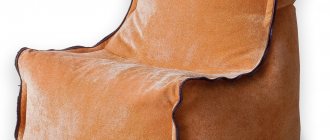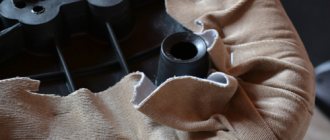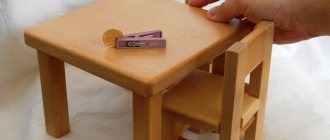Sewing a cover for a chair solves several problems at once. Firstly, with the help of such a protective product you can protect your furniture from contamination. Secondly, if this piece of furniture is already old, then with the help of a cover you can reliably hide scuffs or stains. Thirdly, if you are changing the decor, then new hand-sewn chair covers will help transform the room in accordance with the changed style of the room.
Skirt trim gives a more subtle look than formal trim. It is well suited for situations where you need to hide scratched or unattractive legs. Since the skirt is sewn separately, it is easy to make and will hold up better if hung from the finished cover. It is worth noting that the manufacturing procedure is the same regardless of whether you are sewing a cover for a chair or a sofa.
This page provides detailed step-by-step instructions on how to sew a chair cover yourself.
Sewing a chair cover with your own hands: fitting
Step 1: Pin fitting the inside of the chair
Before sewing a cover for a chair, you need to adjust the inside of the backrest. This is done as follows:
- Place the still uncut fabric on the inside of the back of the chair. The fabric should hang at least 1 inch over the outer back, unless you use a paneling strip. In this case, the fabric should hang down by 10 cm.
- Secure the fabric with a T-needle in the center of the inside back. Straighten the fabric, smoothing it to the sides and then up and down.
- Make sure that the longitudinal thread of the fabric runs perpendicular to the floor. Pin from the center down first and then pin the sides. As you work, continue to smooth and stretch the fabric.
- If you don't want a piping strip, pin the fabric along the top edge of the back.
- Pin a 2.5cm deep fold along the top edge of the inside back piece.
- To sew your own chair cover as neatly as possible, smooth the fabric onto the platform. Start from the center and, working alternately towards one side or the other, pin the fabric along the top edge of the back of the chair.
- In the place where the fabric passes from the inner back of the chair to the seat, an additional 15-30 cm of fabric is required to “tuck” it and fold it. The exact amount of fabric for this depends on the depth of the chair at that point. Using your hands, smooth the fabric between the backrest and the seat.
- Check the direction of the longitudinal threads of the fabric, then smooth and pin the seat platform in the same way as the inside of the backrest. First, pin the fabric evenly in the center, then along the sides, then the front and back edges of the platform.
- Pull the fabric down the front of the chair. Smooth and pin along the center line, then along the sides.
Next, to sew a cover for the chair, you need to make a trim strip. This is a kind of platform for fabric that runs along the top of the chair, connecting the inner and outer (back) part of the back. The easiest way to cover this area is to pin it as an extension of the inside back.
Next, adjust the seat.
The next stage of sewing a chair cover with your own hands is making the front apron.
Why do you need a new furniture cover?
Even the highest quality and most expensive upholstery of upholstered furniture can lose its beautiful appearance over time, especially if there are small children and animals in the house. Exacerbating factors can be direct sunlight, grease and soot when it comes to kitchen furniture. Replacing upholstery can be quite expensive.
In this case, removable covers for chairs and sofas, which can give new life to an aged covering, are an excellent option. In addition, the cape will save the newness of the fabrics from wear and tear if you put it on immediately after purchasing a piece of furniture. It will protect against pollution, animal attacks and children's activity.
Even after liquids and other dirt get on it, the product can be easily removed and washed. It does not require ironing.
An excellent invention is a stretch Euro-cover that stretches over the chair and fits tightly to its surface, imitating factory upholstery. Such models are recommended for use by those who like to change styles and colors in the interior, since at any time you can dress up your favorite chair in a new look.
How to sew a chair cover yourself: trimming and finishing with cord
Step 2: Trimming the Fabric
- To sew your own chair cover, trim the fabric 5 cm below the twill tape.
- Trim the fabric along the sides of the seat platform, leaving 6 inches of extra fabric to tuck in where the seat meets the inside of the side armrests.
- Trim all other seam allowances to 2.5 cm. Where you need to straighten and stretch the fabric, cut it.
Note. When you sew, the seam allowances will need to be trimmed to 12mm.
Step 3: Cord Finishing
- Pin the cord in place, around the inside of the back, along any seam line that needs to be trimmed. Cut the cord where you need to fit it into different notches or corners. If you prefer, you can hand baste the cord into place to make it easier to work with.
- If the cover has a trim strip, make a faint line into the fabric along the fold, then pin the cord into place along the seam line of one of the sections.
The cord finishing of a hand-made chair cover is shown in the photo:
Choosing material
The modern market is quite diverse in the choice of textile products. And even the most capricious housewives can find something they like.
Bright chair covers will be an excellent color accent.
And in order to sew a furniture cover for a sofa or a cover for a computer chair, the following alternatives will be optimal.
- Velours. The material is quite soft with a velvety texture. However, unlike velvet, it is a more budget option. Due to the varied arrangement of the pile, it is combed, laid and smoothed in different ways.
According to the type of production, velor can be smooth, embossed and shaped.
The fabric is easy to care for. Has hypoallergenic properties. This type of material is wear-resistant, and stains are removed quite easily.
The fabric for the future cape should be chosen in accordance with the existing interior style.
- Cotton. It has an important quality - naturalness. As a result, the fabric belongs to the category of “breathable” and environmentally friendly fabrics.
Since cotton is susceptible to coloring, covers made from this material are bright.
The material is short-lived due to the absence of artificial fiber. Cotton fabric also shrinks after washing.
The main criterion for choosing a cover for children's furniture is the environmental friendliness and hypoallergenic nature of the fabric.
- Flock. Soft, delicate, but at the same time quite durable material, which makes it a worthy option for chair covers. The material does not deform, which means that even with long-term use, a bedspread made of this fabric can retain its original appearance.
This modern fabric is similar to velvet.
Also, the advantages of flock include such qualities as ease of operation and subsequent care, water-repellent properties, and resistance to sunlight.
High-quality flock has a three-layer structure, which is quite resistant to wear, stretching and has a large margin of safety.
How to sew a chair cover with your own hands: basting and fitting
Step 6: Basting with Pins
To make a chair cover the way the correct technology suggests, you need to pin together all the parts, working in the same order as when fitting with pins.
- For seams that include cord, turn the seam allowance up to 1 inch without the cord. Pin, matching the seam lines to align the seam allowances with the cord.
- Pin the other seam allowances together, connecting the front of the armrest and the inside of the armrest to the seat.
- Pin and then hand baste the cord along the seam line where the inside and outside back pieces will meet.
Step 7: Pinning the Back of the Back
- Center and pin the fabric to the outside back of the chair the same way you did the inside back, then pin along the twill tape.
- Trim the fabric 5cm below the twill tape; trim seam allowances to 2.5 cm.
- Split the top edge of the outer back and pin to baste the fabric to the inside of the back. Repeat the procedure with the side seams.
Step 8: Assembling the Case
- Pull out all the T-shaped needles that held the fabric to the chair. To create the zipper opening, split the back side seam (the one to your right if you're facing the back of the chair) 5cm from the top. Carefully remove the cover from the chair.
- Starting from the inside of the back, stitch all the arrows, then stitch the facing strip to the inside of the back.
- Sew the inside of the backrest to the inside of the armrests, cutting the fabric at the corners if necessary and folding the fabric so that the seam lines line up with the folds.
- Next, to sew your own chair cover, stitch the front part of the armrest to the inside of the armrest, cutting the fabric at the curves if necessary.
- Sew the outside of the armrest to the inside of the armrest, then to the front of the armrest.
- Sew the platform to the inside of the armrest along the hem (turn) allowance.
- Sew part of the shoulder area to the inside of the armrest, the inside of the back and the trim strip.
- Sew the outer part of the back to the top and sides of the cover, leaving about 5 cm of the right side seam unsewn at the top. If you. close the opening with a zipper, then fold the seam allowances of the outer back under the bottom and baste. Do not cut the seam allowances along the zipper opening; the final width should be 2.5cm.
- Once the entire cover is sewn, put it back on the chair or sofa. Pin the opening for the zipper. Adjust the parts of the fabric that need to be tucked in so that they are in place. Place pillows on the chair.
All seams will be sewn in the same order as they were pinned. Before you sew the cord seam, pull and trim all the cords so that there is an inch left at the end, this way your fabric will not bunch up. As you sew each seam, trim the seam allowances to 1.2 cm.
This video demonstrates how to assemble a chair cover with your own hands:
How to sew a chair cover with your own hands: installing a zipper (with video)
Step 11: Installing the Zipper
- Place the open zipper, face down, over the right side of the opening so that the zipper teeth just barely cover the edge of the cord, with the zipper tape inside the seam allowance. The end of the zipper should be 1.2 cm from the bottom edge of the skirt, and the end of the tape should be turned up.
- Poke me. Then baste the zipper into place, taking only the cord and the cover's seam allowance.
- Using a zipper foot, stitch the zipper, being careful to stitch as close to the cord as possible.
- Close the zipper. Place the ironed edge of the opening over the zipper so that it reaches the cord. Pin, then baste in place. Also, using a zipper foot, sew a seam across the bottom of the zipper, then stitch down to within 1.5cm of the pressed edge.
Step 12: Attach the cover to the chair
Wrap the twill ribbon around the legs and tie. To prevent the finished cover from slipping during use, stuff the folded areas around the seat platform with scraps of fabric or tightly rolled magazines.
To reinforce the material, watch the video “How to sew a chair cover with your own hands”:











